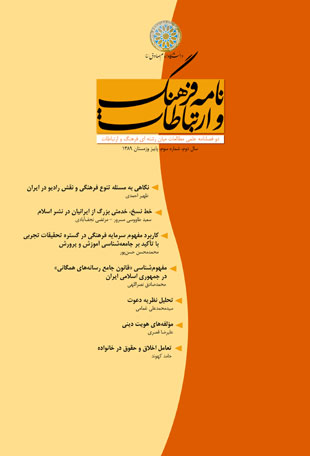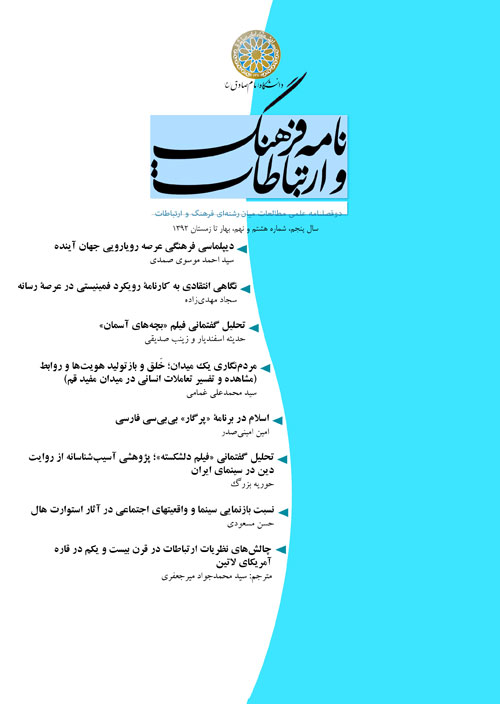فهرست مطالب

نشریه مطالعات میان رشته ای فرهنگ و ارتباطات
پیاپی 3 (پاییز و زمستان 1389)
- تاریخ انتشار: 1390/08/01
- تعداد عناوین: 10
-
صفحه 1
-
صفحه 3
-
صفحه 111
-
صفحه 137
-
صفحه 171
-
Page 5Culture has in its broad sense of the word both subjective and objective dimensions. It encompasses knowledge, ideas, art, ethics, language, customs, lifestyles and in sum, the totality of social life. We can, therefore, maintain that there is no such thing as uncultured human, and in proportion to natural and biological diversity, there exists cultural diversity among nations. Hence while the right to live is respected for all peoples, the same should be applied to their cultural diversity as a necessary component of today’s modern world. To this end, UNESCO’s universal declarations have also approved of this fact and have requested all states and nations to respect and accept this in order to maintain international peace and peaceful life. In this article, the issue of cultural diversity and the role of the radio in Iran is surveyed. There is an initial definition of culture and cultural diversity followed by a discussion about the mass media and cultural diversity, UNESCO’s universal declaration and cultural diversity, the radio and the local radio’s role in this regard, its role in reinforcing social integrity, special functions of local radios, and localradios in Iran.
-
Page 35After the revelation of the Holy Quran to Prophet Mohammad (pbuh), Muslims set to work to write the Holy Verses, but due to the peculiarity of Kufi script and unskillful writing of some of the Prophet’s Companions, neither the recent Iranian and Egyptian converts nor some of the Arabs themselves could easily read the Book. Thus some efforts were done to improve the existing Kufi script. Abolasvad Dowli was a pioneer of making the improvement by applying diacritical marks to Arabic letters. Also under Abdolmalik-ibn-Marvan, they devised some measures such as dotting some letters like ث, ت, ب. None of these, however, could answer to the above-mentioned difficulties till an Iranian artist named Ibn-Moqlah removed the problems by inventing a new script called the new Naskh. This script abrogated other forms of writing and has been used till now as the most conventional script for writing the Holy Quran. This article tries to bring into focus the Muslim Iranians’ contribution to the propagation of Islam by introducing two prominent ones: Ibn-Moqlah, and Ibn Bavad.
-
Page 55Cultural capital is a much used term in contemporary ultural theory and sociology of education. It was first proposed y the French sociologist Pierre Bourdieu and experimented after im in many researches. He believes it to be a determining factor f an individual’s social status. Experimental researches utilize cultural capital to explain the role of educational systems in distributing and increasing that among students with different social backgrounds. Apart from sociology of education, the concept of cultural capital is functional in other fields such as sociology of culture, cultural consumption and also economics and culture, and modern technology. This concept after entering experimental researches especially in the Anglophone world was interpreted in combination with Weber’s theory of social status and in the framework of non-economical factors affecting educational and social progress, getting farther away from Bourdieu’s concept. In the first part of the article various experimental researches are introduced by using the concept of cultural capital divided into three groups: traditional approaches, those tending towards conceptual development and critical approaches. In the second part, the application of this concept in educational research is considered in detail. Then some few researches using this concept of cultural capital in Iran are presented in order to bring into focus the extensive possibilities provided by this concept for doing research with various social and cultural dimensions.
-
Page 85The Fourth Development Plan Law passed in 1383 has obliged the government to draft the General Mass Media Law. This, however, hasn’t been carried out after a period of six years. The obligation has once again been reiterated by the Fifth Development Plan. It is believed that this refusal is due to the ambiguity of the law. The purpose of this article is to elaborate in a step by step and logical manner the concept of the above-mentioned law in the Islamic Republic of Iran. To this end, we have first defined the keyword general law. Then we have explained our understanding of the mass media and eventually we have reached a final definition of the “General Mass Media Law” by combining the two previouslymentioned definitions.
-
Page 111The aim of this research is to identify and formulate the major issues dealt with by Islamic scholars of da’wat (invitation, call). These are categorized in three linguistic groups, namely, Farsi, Arabic, and English and are analyzed in two separate chapters: Muslim and non-Muslim scholars. The results are then classified into six conceptual models: communication, behavior and discourse, power, dialog, compulsion and reluctance, and organization. The communication model concerns the process of da’wat starting from the sender and proceeding to the receiver. Taking notice of expressive and non-expressive methods, and also the combination of knowledge and practice makes a major part of da’wat theories. The issue of power becomes meaningful by differentiating between the practices of calling to good deeds and preventing vices on the one hand and da’wat on the other. Dialog is a concept that gains its importance from our interpretation of other concepts like propagation (of ideas) and da’wat. The relation between jihad and da’wat has prompted most reflection upon the latter. Meanwhile, lacking in a special establishment for da’wat in the history of Islam has been a big question for many orientalists.
-
Page 137Among multiple forms of identity, we should assert that religious identity assumes a prominent place since it plays a determining role in helping individuals know themselves. It could be claimed that its reinforcement can sustain other aspects of identity. Contrariwise, its being challenged may create crisis in that area. This is especially true in societies where religion has a pivotal status. Thus, the assessment of religious identity can be a remarkable field of interest for those concerned. To do this, it is necessary to determine the pertinent constituents. Religious identity has various ideological, devotional, ethical, and faith-related features, each possessing its proper constituents. This article has examined the relation between religiousness and religious identity together with the assessment factors provided by Iranian sociologists and psychologists. It has tried to answer this question: What are the religious identity constituents that can be used in designing a suitable questionnaire for doing a scientific research?
-
Page 171Family is the noblest social institution and the major place for human exaltation. Societies’ health and happiness also depend on family integrity. Though a legal and jurisprudential attention to the family is necessary and the couples’ relationship must answer to that necessity at the minimum, one should not overlook the predominance of ethical standards in this regard. Among these, good companionship holds a particular place and is regarded to be a proof of legalization of those standards. This is rooted in the Quranic concept of good companionship with one’s spouse. The term ma’roof in the Quran implies both a praiseworthy act and a conventional one which are in their turn some ethical and value-laden concepts. According to the jurists, the couples’ good companionship should be in conformity with the existing conventions both in time and place. Therefore, there is a variety of good companionship in proportion to cultural and conventional norms. In our legal system, the couples’ obligations to give a combined assistance to the consolidation of family, children’s upbringing, mutual fidelity and shared domicile are some of the requirements for good companionship.


